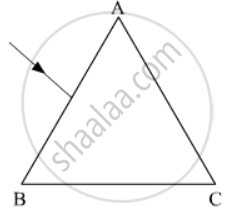Advertisements
Advertisements
प्रश्न
Solve Numerical example.
A monochromatic ray of light is incident at 37° on an equilateral prism of refractive index 3/2. Determine angle of emergence and angle of deviation. If angle of prism is adjustable, what should its value be for emergent rays to be just possible for the same angle of incidence?
उत्तर
By Snell’s law, in case of prism,
n = `sin("i")/sin("r"_1)`
∴ `3/2=sin(37°)/sin("r"_1)`
∴ r1 = `sin^-1(0.6018/(3//2))`
= sin−1 (0.4012)
= 23°39’
For equilateral prism, A = 60°
Also, A= r1 + r2
∴ r2 = A − r1 = 60° – 23°39’ = 36°21’
Applying snell’s law on the second surface of prism,
`1/"n"=sin("r"_2)/sin("e")`
∴ `2/3=sin(36°21’)/sin("e")`
∴ e = `sin^-1((0.5927)/(2//3))`
= sin–1 (0.889)
= 62°44’
≈ 63
For any prism,
i + e = A + δ
∴ δ = (i + e) − A
= (37 + 63) − 60
= 40°
For an emergent ray to just emerge, the angle r2’ acts as a critical angle.
∴ r2’ = `sin^-1(1/"n")`
= `sin^-1(2/3)`
= 41’48°
As, A = r1 + r2 and i to be kept the same.
⇒ A’ = r1 + r2’ = 23°39’ + 41°48’
= 65°27’
- Angle of emergence and angle of deviation in first case are 63° and 40° respectively.
- For emergent ray to just emerge with same incident angle the angle of prism should have the value of 65°27’.
APPEARS IN
संबंधित प्रश्न
State the conditions required for total internal reflection of light to take place
Name the factors affecting the critical angle for the pair of media.
The figure shows a ray of light falling normally on the face AB of an equilateral glass prism having refractive index`3/2`, placed in water of refractive index `4/3`.Will this ray suffer total internal reflection on striking the face AC? Justify your answer.

A light ray does not bend at the boundary in passing from one medium to the other medium if the angle of incident is ______.
State two conditions necessary for total internal reflection to occur.
Plot a graph between
Angle of incidence versus angle of reflection,
Make the correct choices for each of the following :
Total Internal reflection takes place when
(where ∠i = angle of incidence, ∠r = angle of refraction, ∠C = critical angle)
State two advantages of using a right-angle prism as a reflector, rather than a plane mirror.
Images formed by totally reflecting prisms are brighter than the image formed by ordinary reflected light, why?
State one factor on which a critical angle for a given pair of media depends. The critical angle for the glass-air interface is 45° for the yellow light. Will it be equal to, less than or greater than 45° for (i) red light, (ii) blue light?
Name the factors affecting the critical angle for the pair of media.
Choose the correct option.
Consider the following phenomena/ applications: P) Mirage, Q) rainbow, R) Optical fibre and S) glittering of a diamond. Total internal reflection is involved in
Choose the correct option.
Select the WRONG statement.
Answer the following question.
Describe the construction and working of an optical fibre.
Answer the following question.
What are the advantages of optical fibre communication over electronic communication?
Answer the following question.
Why is prism binoculars preferred over traditional binoculars? Describe its working in brief.
A green light is incident from the water to the air-water interface at the critical angle `(theta)`. Select the correct statement
For a ray of light, the critical angle is minimum when it travels from ______.
The critical angle is defined as the angle of incidence at which the total internal reflection starts to occur.
Write any two uses of total internal reflection.
A green light is incident from the water to the air-water interface at the critical angle (θ). Select the correct statement.
A ray of light incident at an angle θ on a refracting face of a prism emerges from the other face normally. If the angle of the prism is 5° and the prism is made of a material of refractive index 1.5, the angle of incidence is ______.
Which of the following is used in optical fibres?
The angle made by incident ray of light with normal of the reflecting surface is called ______.
